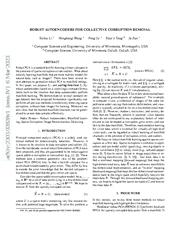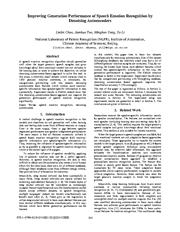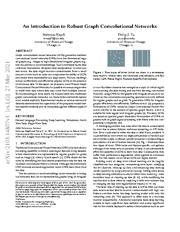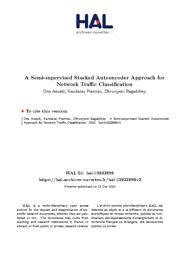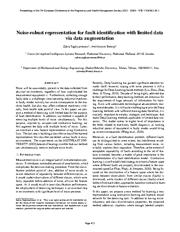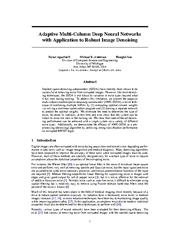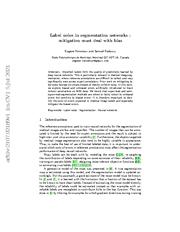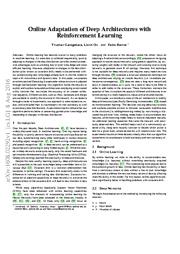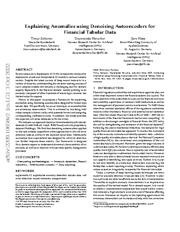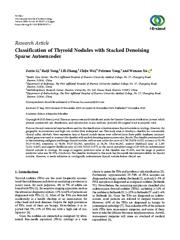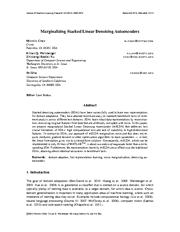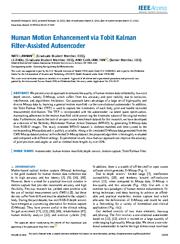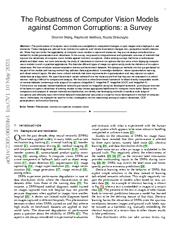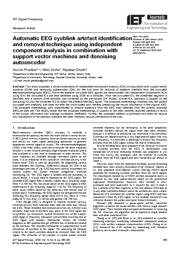A copy of this work was available on the public web and has been preserved in the Wayback Machine. The capture dates from 2023; you can also visit the original URL.
The file type is application/pdf.
Filters
Robust Autoencoders for Collective Corruption Removal
[article]
2023
arXiv
pre-print
We demonstrate on several standard image datasets that the proposed formulation significantly outperforms all previous methods in collectively removing sparse corruption, without clean images for training ...
Robust PCA is a standard tool for learning a linear subspace in the presence of sparse corruption or rare outliers. ...
Collective manifold learning and corruption removal is performed on these samples. Then, generalization of the learned model is tested on the 10, 000 unseen corrupted samples from Section 4.3. ...
arXiv:2303.02828v1
fatcat:brvhdklibjahjhqk47b6vvjrfm
Improving generation performance of speech emotion recognition by denoising autoencoders
2014
The 9th International Symposium on Chinese Spoken Language Processing
In order to achieve this objective, we utilize denoising autoencoders based approach to solve this task. ...
Experiment results in CASIA dataset show that this denoising autoencoders based approach can improve the generation performance of speech emotion recognition significantly. ...
Denoising Autoencoders Denoising autoencoders is a stochastic version of autoencoders. It is trained to reconstruct the input from a corrupted version of it. ...
doi:10.1109/iscslp.2014.6936627
dblp:conf/iscslp/ChaoTYL14
fatcat:oitjxbdbrbfdrmv7wwghwpb2du
An Introduction to Robust Graph Convolutional Networks
[article]
2021
arXiv
pre-print
In this paper, we propose a novel Robust Graph Convolutional Neural Networks for possible erroneous single-view or multi-view data where data may come from multiple sources. ...
Due to inevitable faulty data collection instruments, deceptive data manipulation, or other system errors, the data might be error-contaminated. ...
The preprocessing for text view consists of removing infrequent words, computing TFIDF for 2711 top words. For image view, we normalize the images. ...
arXiv:2103.14807v1
fatcat:52zu625fdve4ln3oxwjxjxlea4
A Semi-supervised Stacked Autoencoder Approach for Network Traffic Classification
2020
2020 IEEE 28th International Conference on Network Protocols (ICNP)
To achieve these goals, we propose an approach using stacked sparse autoencoder (SSAE) accompanied by denoising and dropout techniques to improve the robustness of extracted features and prevent the over-fitting ...
We deployed deep learning because of its unique nature for solving problems, and its ability to take into account both labeled and unlabeled data. ...
Denoising autoencoder Denoising autoencoder was proposed in [14] to improve the robustness of feature representation. It is trained to reconstruct a clean input from a corrupted version of it. ...
doi:10.1109/icnp49622.2020.9259390
dblp:conf/icnp/AouediPB20
fatcat:pxi63kn33vgmngspramo3rpyzm
Noise-Robust Representation for Fault Identification with Limited Data via Data Augmentation
2022
Proceedings of the European Conference of the Prognostics and Health Management Society (PHME)
In this paper, we propose a method of denoising with limited data for the purpose of fault identification. In addition, our method is capable of removing multiple levels of noise simultaneously. ...
Noise will be unavoidably present in the data collected from physical environments, regardless of how sophisticated the measurement equipment is. ...
Moreover, dropout is used during the training process of Denoising Autoencoders to not only prevent the network from overfitting, but also improve the robustness of the network towards noise presence. ...
doi:10.36001/phme.2022.v7i1.3334
fatcat:3vcczvhnine4bcdf63yt4rjksu
Robust Image Denoising with Multi-Column Deep Neural Networks
2013
Neural Information Processing Systems
Stacked sparse denoising autoencoders (SSDAs) have recently been shown to be successful at removing noise from corrupted images. ...
However, like most denoising techniques, the SSDA is not robust to variation in noise types beyond what it has seen during training. ...
We also thank Roni Mittelman, Yong Peng, Scott Reed, and Yuting Zhang for their helpful comments. ...
dblp:conf/nips/AgostinelliAL13
fatcat:mpjtzuhjrzdv7ekh5p77vitik4
Mitigating the Impacts of Covert Cyber Attacks in Smart Grids Via Reconstruction of Measurement Data Utilizing Deep Denoising Autoencoders
2019
Energies
For a robust, multivariate reconstruction of the attacked measurements from multiple sensors, the denoising autoencoder is used. ...
To this end, in this paper, we propose a novel idea for the reconstruction of sensor-collected measurement data from power networks, by removing the impacts of the covert data-integrity attack. ...
To reconstruct data by removing bias added by an attacker, we employ a state-of-the-art anomaly reconstruction method: the denoising autoencoder. ...
doi:10.3390/en12163091
fatcat:74zjdxklhrdz7pg3gbuqp54zsm
Label noise in segmentation networks : mitigation must deal with bias
[article]
2021
arXiv
pre-print
We found that supervised and semi-supervised segmentation methods are robust or fairly robust to unbiased errors but sensitive to biased errors. ...
This is particularly relevant in medical image segmentation, where reference annotations are difficult to collect and vary significantly even across expert annotators. ...
Model performance on corrupted labels We aim to evaluate the robustness of segmentation models to errors in the reference annotations. ...
arXiv:2107.02189v1
fatcat:odg3nzq6vjbfpotr3idcdu4zfm
Online Adaptation of Deep Architectures with Reinforcement Learning
[article]
2016
arXiv
pre-print
As we observe through a series of experiments, our approach is more responsive, robust, and principled than its counterparts for non-stationary as well as stationary data distributions. ...
In this paper, we propose an online stacked Denoising Autoencoder whose structure is adapted through reinforcement learning. ...
We gratefully acknowledge the support of NVIDIA Corporation with the donation of the GPU used for this research. ...
arXiv:1608.02292v1
fatcat:hqmphzmqwbga5gaepdq6ftaanu
Explaining Anomalies using Denoising Autoencoders for Financial Tabular Data
[article]
2022
arXiv
pre-print
Hence, in this paper, we propose a framework for explaining anomalies using denoising autoencoders designed for mixed type tabular data. ...
We find that denoising autoencoders applied to this task already outperform other approaches in the cell error detection rates as well as in the expected value rates. ...
We thank the members of the statistics department at the Deutsche Bundesbank for their valuable review and remarks. ...
arXiv:2209.10658v2
fatcat:akeaaodujzcqzekbyidc3lgozy
Classification of Thyroid Nodules with Stacked Denoising Sparse Autoencoder
2020
International Journal of Endocrinology
This study aims to develop a classifier for conveniently clinical utility. Methods. Gene expression data of thyroid nodule tissues were collected from three public databases. ...
Immune-related genes were used to construct the classifier with stacked denoising sparse autoencoder. Results. ...
Acknowledgments Zexin Li would like to thank Wenwen Huang for her full support. is study was supported by the National Natural
Supplementary Materials Supplementary material is an excel file. ...
doi:10.1155/2020/9015713
pmid:33488708
pmcid:PMC7787836
fatcat:tzhitvm5xfe3xk6hcfagcwqmgy
Marginalizing stacked linear denoising autoencoders
2015
Journal of machine learning research
Stacked denoising autoencoders (SDAs) have been successfully used to learn new representations for domain adaptation. ...
SDAs learn robust data representations by reconstruction, recovering original features from data that are artificially corrupted with noise. ...
Acknowledgements We would like to thank Laurens van der Maaten for pointing out the alternative Ridge Regression formulation of mSLDA under blank-out corruption. ...
dblp:journals/jmlr/ChenWXS15
fatcat:5jawfi3gnrdstid4gwn5fm4l7y
Human Motion Enhancement via Tobit Kalman Filter-Assisted Autoencoder
2022
IEEE Access
Furthermore, due to the lack of an open source benchmark dataset for this research, we have developed an extension of the Berkeley Multimodal Human Action Database (MHAD) by generating D-Mocap data from ...
Our approach takes advantage of a large set of high-quality and diverse Mocap data by learning a general motion manifold via the convolutional autoencoder. ...
Two data sets of real-world D-Mocap data were used for robustness in analysis. ...
doi:10.1109/access.2022.3157605
pmid:36090467
pmcid:PMC9455937
fatcat:cbmye3lci5bkvbnkjpk4xtz4yy
A Survey on the Robustness of Computer Vision Models against Common Corruptions
[article]
2024
arXiv
pre-print
We also cover indirect methods for generalization and mitigation of shortcut learning, potentially useful for corruption robustness. ...
We provide an experimental overview of the base corruption robustness of popular vision backbones, and show that corruption robustness does not necessarily scale with model size. ...
An algorithm [34] for training an autoencoder with corrupted images only was shown to be capable of removing photographic noise. ...
arXiv:2305.06024v3
fatcat:z7m5tpsz6fbzri7elnwyqg3ugi
Automatic Eyeblink Artefact Identification and Removal from EEG Using Independent Component Analysis in Combination with Support Vector Machines and Denoising Autoencoder
2020
IET Signal Processing
This study proposes a novel combination of independent component analysis (ICA) in conjunction with support vector machine (SVM) and denoising autoencoder (DA), for the first time, for removal of eyeblink ...
The proposed methodology was implemented to remove eyeblinks from the EEG data collected from the publicly available EEGLab data set. ...
Hence, the proposed method is more robust in handling artefacts and also it distorts the EEG minimally. • On the contrary of standard autoencoder, this study proposes DA for denoising the eyeblink artifact ...
doi:10.1049/iet-spr.2020.0025
fatcat:3n4witfbzbgrnnnsygddnezs5y
« Previous
Showing results 1 — 15 out of 2,607 results

